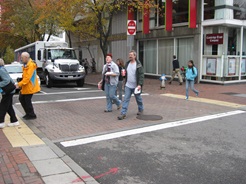Accessibility

Sidewalk Width
Both the 1996 Massachusetts Architectural Access Board (MAAB) regulations and the 2010 Americans with Disabilities Act (ADA) Standards for Accessible Design mandate a minimum width of four feet of unobstructed sidewalk passageway, exclusive of curb. Sidewalks less than five feet wide are required to include a five-by-five-foot passing space every two hundred feet.
In addition to the 2-5% of the population who have permanent mobility disabilities, most people experience at least a temporary mobility impairment at some time their lives, so making sidewalks usable for people with disabilities improves access for everyone.
Options for widening sidewalks and narrowing streets are considered whenever roads are reconstructed. Bicycle facility improvements are also considered.
On streets with little foot or automobile traffic, decisions about changing the width of sidewalks are made on a street-by-street basis, taking into account cost, drainage, utility locations, heights of thresholds along the sidewalk, vegetation, and other factors. In general, sidewalks on quiet residential streets can be narrower than sidewalks on busy commercial streets. Mailboxes, signs, posts, benches, bus shelters, trash cans, signal control boxes, and other sidewalk furniture should be placed near the curb and not interfere with pedestrian traffic or with the ability of pedestrians, including children and people using wheelchairs, to see cars and be seen by motorists at intersections. It is also important that snow removal be kept in mind when deciding how much space to allot to cars and how much to give sidewalks.
In commercial areas, wide sidewalks are usually important for pedestrians to feel comfortable. People tend to avoid the edges close to the street or to abutting buildings. In general the travel area should be at least eight feet wide, wide enough for two pairs of pedestrians to pass each other comfortably.
City sidewalks are important social spaces as well as travel routes, and room for people to stop and talk or to stand and watch must also be factored into calculations of optimal sidewalk widths, especially in commercial areas. Nonetheless, it is not the case that sidewalks should always be as wide as possible.
Pedestrian Curb Ramps
ADA and MAAB regulations require pedestrian ramps at all street crossings. Pedestrian access routes, including temporary routes where there is construction, should all be accessible. City policy is that newly constructed curb ramps must be made of concrete and must have cast iron detectable warning panels. Detectable warning surfaces (also known as truncated domes) help provide tactile cues for people who are visually impaired. While all major sidewalk reconstruction includes installing curb ramps, the City also has a program to reconstruct shorter segments in poor condition in high priority areas, which include areas that the Disabilities Commission identifies as priorities.
For More Information
For more information please contact the Commission for Persons with Disabilities at 617/349-4692.